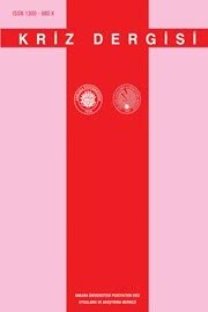CAN SIKICI ÜÇLEME: İNTİHAR, ERGENLİK DÖNEMİ, İLAÇLAR…
Giriş: İntihar, dünyada önde gelen ölüm nedenlerinden biridir (Mgaya, Kazaura, Outwater ve Kinabo 2008) DSÖ verilerine göre, ülkemizdeki intihar hızı düşük olmakla birlikte, intihar girişimlerinin son 20 yılda özellikle ergen yaş grubunda belirginleşmesi dikkat çekicidir(Dilsiz&Dilsiz 1993, Uçan 2005). Biz çalışmamızda intihar girişimi ile başvuran hastaların epidemiyolojik özelliklerini tanımlamaya, girişim yöntemleri ve yaş grupları açısından yoğunluğu fazla olan gruplara dikkat çekmeye çalıştık. Metod: Çalışmamızda Gazi Üniversitesi Tıp Fakültesi (GÜTF) Hastanesi Erişkin-Çocuk Acil Servisi’ne Aralık 2009-Ocak 2010 tarihlerinde intihar girişimi ile başvuran hastaların dosyaları retrospektif olarak incelendi. Bulgular: 71 hastanın %80.3’ü kadın, yaş ortalaması 22.73±10.1 olup, %72’si 12-24 yaş grubunda yer almaktaydı. %95.8’nin
Anahtar Kelimeler:
İntihar, ergen, ilaç, acil servis
CAN SIKICI ÜÇLEME: İNTİHAR, ERGENLİK DÖNEMİ, İLAÇLAR…
Introduction: Suicide is one of the most important reasons of death in the world (Mgaya, Kazaura, Outwater ve Kinabo 2008)According to WHO data, it is important to pay attention to increasing rate of suicide in adolescent age groups last 20 years(Dilsiz&Dilsiz 1993, Uçan 2005).n this study, we tried to analyze epidemiologic specifications and suicide methods according to age groups. Method: We retrospectively reviewed files of the patients who presented with suicide to the Gazi University Emergency Department (adult and pediatric) between December 2009 and January 2010.Results: Female gender was 80.3% of 71 cases. Mean age was 22.73±10.1 and majority of the cases (72%) was in the age group of 12-24. General clinical situation were good in 95.8% of cases. 20 cases had previous psychiatric diagnosis, 13 cases had chronic organic disease, and sexual abuse was found in a case. It is the first suicidal attempt in 68 cases. 59 of cases were discharged from the ED after short period of observation. 9 cases were admitted to ward and 3 cases leave the ED without permission despite to medical advice. There is no death in the study group. Suicide method was drug ingestion in 90.2% of cases. Multiple drug ingestion was found in 45% of cases. Paracetamol and salycilates were the most common ingested drug group (39.4%). Presentation of the cases to the ED was found mostly in first hour of the suicidal attempt. Conclusion: We found that suicidal attempt was the highest in the age group of 12-24 in our study. Drug ingestion was the common route of suicidal attempt and it is concordant with literature. In addition to our results, we wanted to pay attention to easy reach to drugs and to precautions. Suicide is one of the most important reasons of death in the world1 . According to WHO data, although the suicide rate is low in our country, it is important to pay attention to increasing rate of suicide in adolescent age groups last 20 years (Uçan 2005, Dilsiz ve Dilsiz 1993). In this study, we tried to analyze epidemiologic specifications and suicide methods according to age groups.
Keywords:
Suicide, adolescent, drug, emergency department.,
___
- Altındağ A, Sır A, Özkan M (2001) Türkiye’de intihar hızlarındaki değişimler (1974-1998). Türkiye’de Psikiyatri; 2:79-86.
- Asirdizer M, Yavuz MS, Demirag Aydin S, Dizdar MG (2010) Suicides in Turkey Between 1996 and 2005: General Perspective. Am J Forensic Med Pathol ; 31:138-45.
- Başbakanlık Devlet İstatistik Enstitüsü (2000):İntihar İstatistikleri, Başbakanlık Matbaası, Ankara.
- Camidge DR, Wood RJ, Bateman DN(2003) The epidemiology of self- poisoning in the UK. Br J Clin Pharmacol; 56:613-9.
- Dilsiz A, Dilsiz F. İntihar girişimlerinde belirtilen nedenler. Kriz Dergisi 1993; 1:124-8.
- Fawcett J, Shaughnessy R(1989) The suicidal patient. JA Flaherty, RA Channon, JM Davis (eds), Psychiatry; 49-56.
- France K (1990) Crısıs Interventıon A Handbook of Immedıate Person- to-Person Help Charles Thomas Publısher, Illinois, USA, 61-77
- Kekec Z, Yıldırım C, İkizceli İ, Gönül AS, Sözüer EM(2000) Özkıyım girişimi nedeniyle acil servise başvuran hastalarda hazırlayıcı etkenler. Anadolu Psikiyatri Dergisi; 1:157-61.
- Mann JJ(2002) A current perspective of suicide and attempted suicide. Ann Intern Med; 136:302-11
- Meredith TJ. Epidemiology of poisoning. Pharmac Ther 1993; 59:251-6.
- Mgaya E, Kazaura MR, Outwater A, Kinabo L (2008)Suicide in the Dar es Salaam region, Tanzania, 2005. J Forensic Leg Med ;15:172- 6.
- Phillips RM, Liu H, Zhang Y(1999) Suicide and social change in China. Cult Med Psychiatry; 23:25-50.
- Sayar K, Bozkır F (2004) İntihar girişiminde bulunan ergenlerde intihar niyeti ve ölümcüllüğün belirleyicileri. Yeni Symposium; 42:28-36.
- Sayıl I, Devrimci Özgüven H(2002) Suicide and suicide attempts in Ankara in 1998: result of the WHO/EURO. Multicentre Study of Suicidal Behaviour. Crisis; 23:11-6.
- Sayıl I, Oral A, Güney S, Ayhan N, Ayhan Ö, Devrimci H (1993) Ankara’da intihar girişimleri üzerine bir çalışma. Kriz Dergisi; 1:56-61.
- Şenol V, Ünalan D, Avşaroğulları L, İkizceli İ(2005) İntihar girişimi nedeniyle Erciyes Üniversitesi Tıp Fakültesi Acil A.D.na başvuran olguların incelenmesi. Anadolu Psikiyatri Dergisi; 6:19- 29
- Uçan Ö (2005) Türkiye’de intiharı konu alan yayınlar üzerine bir bibliyografya çalışması. Kriz Dergisi; 13:15-26.
- Welch SS(2001) Areview of the literature on the epidemiology of parasuicide in the general population. Psychiatr Serv; 52:368-75.
- Wunderlich U, Bronisch T, Wittchen HU, Carter R(2001) Gender differences in adolescents and young adults with suicidal behaviour. Acta Psychiatr Scand; 104:332-9.
- ISSN: 1300-980X
- Başlangıç: 1992
- Yayıncı: Ankara Üniversitesi
Sayıdaki Diğer Makaleler
Sosyal psikiyatri üzerine bir deneme
Kitap tanıtımı: Bağlanma ve sonraki yaşlarda görülen etkileri
Yetiştirme yurdunda kalan ergenlerin gelecek beklentileri ve sosyal destek algıları
Almanya’da madde bağımlısı çocuk ve gençlere yönelik bir rehabilitasyon modeli: Parceval
Elif GÖKÇEARSLAN ÇİFCİ, Gonca POLAT ULUOCAK
CAN SIKICI ÜÇLEME: İNTİHAR, ERGENLİK DÖNEMİ, İLAÇLAR…
Lale KARAMAN, Okşan DERİNÖZ KILIÇASLAN, Fikret BİLDİK, Ayfer KELEŞ, Ahmet DEMİRCAN
